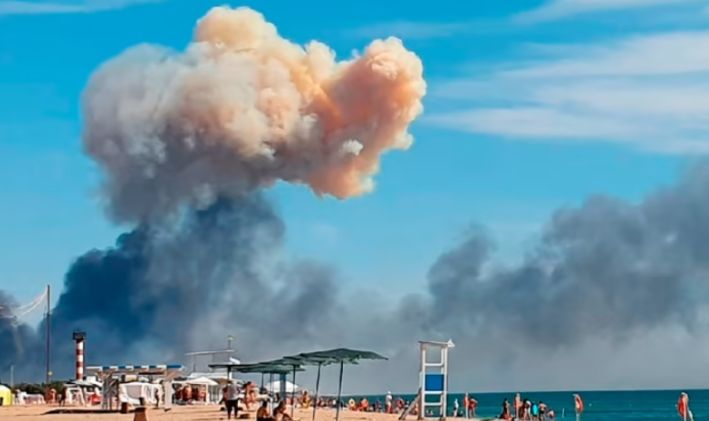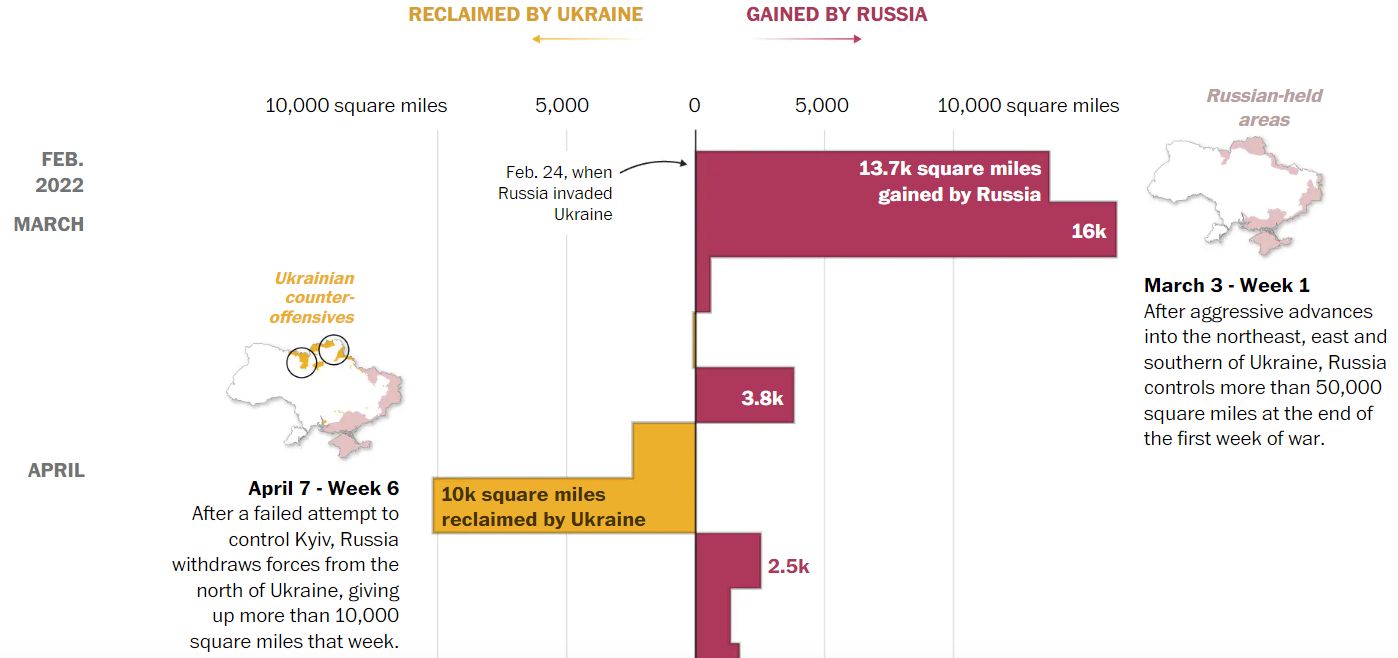By Eric Vandenbroeck
and co-workers
The Ukrainian Saboteurs Behind Enemy
Lines
There recently have
been reports like, for example, Ukrainian saboteurs blew up a Russian
helicopter 500 miles from Ukraine. Or, more recently, how members
of a special forces unit use oars to push their boats into the water while
on a night operation targeting Russian forces behind the front line.
A network of
partisans was activated in late July, just as Ukraine’s elite Special
Operations Forces stepped up their missions in occupied territories, including
using armed drones. The approach has also been helped by the arrival of
US-made, truck-mounted guided missile launchers called Himars,
which have extended the reach of the Ukrainian military to as far as 80km
behind the Russian front lines. The objective was to reach behind the enemy
lines “and teach them chaos, said the Ukrainian official, who asked not to be
named when discussing military strategy. The official said that just because
they have a meat grinder doesn’t mean we have to run into it, referring
to Russian forces’ frontline artillery barrage.
Meanwhile,
in central Kyiv, a tall man in a black hoodie stands outside a cafe
furiously puffing on a vape. His official title, head of the Committee of
Veterans, might sound like the role of a benign public servant, but he is far
removed from parades and ribbon pinning.
He works with those
who secretly fight for Ukraine behind enemy lines. He is one of the leading
strategists and organizers of Ukraine’s partisans inside Russian-occupied
territory. If they kill me, many others can take my place. We’ve had to adapt
and become more creative. They might be strong, but we use our minds.
After Russia invaded
Ukraine on 24 Feb., dormant veterans associations became the lifeblood of the
Ukrainian resistance inside occupied territory. According to him, their
networks relied heavily on dedicated volunteers who were in place months before
Russia’s full-scale offensive in February. We said in 2014 that the Russians
would not stop in those regions. So in a way, the country was preparing,” he
said. Veterans from 2014 were part of this. Almost all of them returned to the
army. We were readying people in areas we knew would be hit early. Even in our
schools, we were psychologically preparing our kids.
Initially,
politicians ignored the loud alarm raised by those inside Ukraine’s military
and security services, preferring to take a wait-and-see approach to the
impending Russian attacks.
After successful
lobbying by people like him, however, the government in July 2021 passed the
Law on the Fundamentals of National Resistance, designed to maximize civilians'
role in Ukrainian defense. It helped establish the territorial defense groups
in neighborhoods and connect these citizen defense groups with Ukraine’s
broader security and military apparatus. By this February, makeshift distribution
centers were established for those without weapons and training to allow
civilians to defend their neighborhoods across the country.

He said that for
Ukrainians, after the initial shock of the attacks of 24 Feb., these local
civil-defense networks began to connect. “On the first day, people were shocked
because rockets were falling and their targeting was not precise, so everything
was hit. After the first two days of shock, people realized we needed to
resist. They started coming together in their groups, he said.
Initially, organizers
like him, many of whom are military veterans with experience in the Donetsk and
Luhansk regions and now work in collaboration with Ukraine’s military and
security service in Kyiv, began to focus on coordinating the flow of
information. They were tasked with figuring out what was being attacked, where
weapons were required, and how to get them there. In occupied places like Sumy
and Kharkiv, where street fighting broke out with Russian forces, the defense
networks relied mainly on former soldiers, who sometimes still bore injuries
from their earlier service, to fight back. These guys know how to use weapons,
RPGs, etc. They trained in the Soviet army, so they knew the tactics of Russia.
We made networks connecting people, but they often used their circles
separately. Entire families got involved, he said.
But the partisans did
not merely consist of former soldiers. He said civil servants, post office
workers, and even hunters played a crucial role in Ukraine’s partisan movement.
People who knew the forests wanted to help us. Some worked in forestry; others
were catching poachers. Their territorial knowledge was unparalleled, so he
said we worked with them to develop new ways to find information on the Russian
movement and see if our actions inside their area had been successful.
One striking anecdote
involves a hunting dog put to work for the national cause. When Russia started
to attack Kyiv, the military realized it was fragile, so it utilized natural
resources. In Kyiv oblast, it started planning how to flood rivers to prevent
Russians from building temporary bridges. On one occasion, when it needed to
raise the level of a river significantly, it hit a dam but had no way to check
whether its attack had provided the desired results.
A local hunter
offered up Kaban, who, equipped with a GoPro camera,
traveled inside Russian-occupied territory to bring back valuable footage sent
via the clandestine partisan network to Kyiv. How did his owner manage to
retrieve Kaban from enemy territory? His owner
whistled for him, he laughed. Through Kaban’s
actions, Ukraine’s security services could confirm their mission was
successful.

The partisans used
any resources available to them in occupied territory. In one mission, weapons
held by border guards were transported to designated areas where locals could
collect them. Meanwhile, women who distributed Ukrainian pensions inside
the occupied territories began to collect information on Russian movements.
Even after pension money ran out, the women continued to travel from house to
house under the pretense of pension distribution.
They were invaluable,
he mused. Because the Russians have discovered these channels, he speaks about
them but says many new methods are being used daily. “So many of our partisans
were killed or tortured, but they keep volunteering, grannies, sisters, and
mothers, he said.
A 46-year-old from
the recently liberated Kherson oblast was part of his partisan network until
his work filming Russian movements led to a brief detention with the enemy—and,
ultimately, a lucky escape. I started filming the Russians and the movement of
weapons on my phone. Finally, they realized someone from my village was
filming, so they closed the checkpoints and started to examine our phones. I
deleted my pictures, but I didn’t delete the trash. When they checked, they
found the photos and tried to take me away. He said many people surrounded
them, and some of my relatives gave them money and cigarettes. For
the 46-year-old veteran, finding a trusted network to send his
videos to took time. Still, as family members learned about his activities,
they offered to help, including his beekeeping father.
At the start, we
didn’t know who to send the coordinates to, so I sent them to the
administration office of the oblast, but then I found a relative who fought in
2014, so he had a much better network. When they started to bomb Kherson,
my father felt terrible and wanted to help. He worked with bees, so he would
send us coded messages about places we kept the bees and things like this:
whether it was busy now. Locations only we knew. There was a time when we
needed to get a view of areas next to the river—even the satellites couldn’t
view this. We pretended to go fishing and were able to report back on the
location.
On the planning
level, we work closely with Ukraine’s more conventional security
service, the SBU, which works on counterinsurgency movements inside
Ukraine. Those in the SBU are officially assigned by the Ukrainian government
with the tasks of mapping out the Russian presence inside Ukraine, hunting for
Russian spies in Ukraine’s ranks, and putting together a picture of how their
counterparts work inside Ukrainian territory. From locating a Russian arms
cache inside Kyiv to discovering a Ukrainian cook who sold the coordinates and
times of meals in a military barracks in Rivne for $300, Ukraine’s security
services are constantly on the alert for Russian insurgents inside the country.
“Sometimes they’ll do it for money, but it’s so small,” Olek,
an SBU officer, told us in Kharkiv oblast while on an intelligence-gathering
mission near the border with Russia.
A lot of our people
were arrested, he admits. In some villages, Russians went house by house, and
they tortured people to get them to give up their networks. Sometimes they
already had lists of veterans. In Kherson, they took databases of all
government employees, especially anyone with a military pension.” When asked
about Ukrainian mayors who said the partisans were capitulating to avoid
civilian casualties, he was firm: They’re lying. That’s an FSB Russia's spy
agency, the Russian Federal Security Service narrative.
As the SBU and its
intelligence officers begin counterinsurgency work in recently liberated
Kherson, he continues to work with partisans inside Russian-occupied territory.
They constantly adapt their tactics to meet new challenges and exploit Russian
weaknesses. Putin didn’t read his history books, or he would have learned about
our partisans, he said. Stalin got to know them quite well.
Kyiv hopes its
tactics of trying to reach behind the lines will also have a psychological
impact on weary opponents. Imagine you’re a Russian soldier, and day after day,
there is a bomb somewhere near you — do you think that soldier can sleep now?
said the second Ukrainian official.

For updates click hompage here